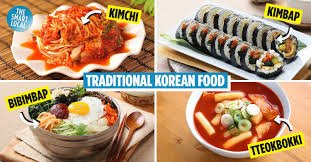
south korean food
Introduction: Why South Korean Food Captivates the World
In recent years, South Korean food has exploded in global popularity, thanks to the rise of K-dramas, K-pop, and global culinary curiosity. But this isn’t a temporary trend—Korean cuisine is deeply rooted in tradition, shaped by geography, climate, and centuries of cultural evolution. With its rich flavors, diverse textures, and vibrant colors, Korean food is both comforting and exciting. From street-side tteokbokki stalls to royal court dishes like sinseollo, South Korean cuisine offers something for every palate. In this article, we explore the foundations, popular dishes, ingredients, etiquette, and cultural impact of Korean food today.
The Foundations of Korean Cuisine
Korean cuisine is built on balance and fermentation. Traditional meals emphasize the harmony of five colors (white, red, green, black, and yellow), five tastes (spicy, sweet, sour, salty, and bitter), and seasonal ingredients. Rice (밥, bap) is the staple of nearly every meal, often accompanied by various banchan (side dishes), soups, grilled meat, and fermented vegetables.
Key components include:
- Fermented foods (like kimchi, doenjang, gochujang)
- Grains and rice
- Vegetables (both raw and pickled)
- Protein (seafood, beef, pork, tofu)
- Broths and stews
- Chili, garlic, sesame oil, and soy-based sauces
Meals are typically served all at once rather than in courses, encouraging communal eating and conversation.
Iconic South Korean Dishes You Must Try
South Korean food offers a wide range of dishes—from spicy and sizzling to cool and refreshing. Here are some signature Korean dishes that define its culinary identity:
1. Kimchi (김치)
Perhaps the most famous Korean food item, kimchi is fermented cabbage or radish mixed with chili flakes, garlic, and other seasonings. It’s tangy, spicy, and full of probiotics, making it both flavorful and healthy.
2. Bibimbap (비빔밥)
A colorful rice bowl topped with sautéed vegetables, a fried egg, and sometimes beef or tofu. It’s served with gochujang (red chili paste), which you mix in before eating.
3. Bulgogi (불고기)
Thinly sliced marinated beef grilled to perfection. The marinade usually includes soy sauce, sugar, garlic, and sesame oil, giving it a savory-sweet taste.
4. Samgyeopsal (삼겹살)
Thick slices of pork belly grilled at the table and wrapped in lettuce with sauces, garlic, and green onions. It’s a social eating experience often enjoyed with friends and soju.
5. Tteokbokki (떡볶이)
A popular street food made of chewy rice cakes in a spicy and slightly sweet gochujang-based sauce. Often includes fish cakes and boiled eggs.
6. Jjigae (찌개)
Hearty stews like kimchi jjigae, doenjang jjigae, or soondubu jjigae (soft tofu stew) are staples of Korean home cooking.
7. Naengmyeon (냉면)
A cold noodle dish served in icy broth, perfect for hot summers. It comes in variations like mul naengmyeon (with broth) or bibim naengmyeon (spicy sauce).
Korean Street Food Culture
South Korean street food is legendary for its affordability and variety. Street markets like Myeongdong in Seoul or Gwangjang Market offer a sensory overload of sizzling pans, skewered snacks, and fragrant stews. Popular street foods include:
- Hotteok (호떡): Sweet pancakes filled with brown sugar, cinnamon, and nuts
- Odeng (오뎅): Fish cakes in hot broth, served on skewers
- Gimbap (김밥): Seaweed rice rolls filled with vegetables and meat
- Sundae (순대): Korean blood sausage made with noodles or rice
- Fried chicken (치킨): Korean fried chicken is double-fried and crispy, often coated in spicy or sweet sauces
These dishes highlight the fast-paced, informal, and flavorful nature of everyday Korean eating.
Korean Food and Fermentation: The Secret Ingredient
One of the most unique aspects of Korean food is its heavy use of fermentation. Kimchi is just the beginning. Other fermented staples include:
- Doenjang (된장): Fermented soybean paste used in stews and soups
- Gochujang (고추장): Spicy fermented chili paste
- Gan-jang (간장): Korean-style soy sauce
- Jeotgal (젓갈): Fermented seafood condiments
These ingredients add depth, umami, and health benefits to everyday Korean cooking. Fermented foods are rich in probiotics and are key to gut health and immunity.
You can read more about the health science behind fermented Korean foods in this Harvard Health fermentation guide.
Etiquette in Korean Dining
Dining in South Korea follows traditional etiquette that reflects respect and community:
- Wait for the eldest to start eating first
- Don’t stick chopsticks vertically into rice (it resembles funeral rituals)
- Use both hands when pouring drinks for elders
- Avoid wasting banchan, even though they’re refillable
- Always return bowls and plates neatly at the end of the meal
In both homes and restaurants, meals are seen as an opportunity to connect, not just eat.
South Korean Drinks That Accompany Meals
Korean meals are often enjoyed with beverages that complement the food’s bold flavors:
- Soju (소주): A clear distilled liquor, usually consumed during social meals
- Makgeolli (막걸리): A milky rice wine, slightly fizzy and lightly sweet
- Bori-cha (보리차): Roasted barley tea, served hot or cold with meals
- Sikhye (식혜): A traditional sweet rice punch served as dessert
Soju and Korean BBQ go hand-in-hand, forming a culinary duo loved around the world.
Korean Food’s Global Rise
Thanks to the spread of Korean pop culture and global media, Korean food is now thriving across the world. Cities like New York, London, Toronto, and Sydney are now home to Korean restaurants, bakeries, and grocery stores. Korean food is also influencing fusion cuisine, such as:
- Korean tacos (bulgogi in tortillas)
- Kimchi pizza
- Gochujang-infused sauces in Western burgers
- Korean-style fried cauliflower or tofu
Cooking shows and YouTube channels have made dishes like bibimbap and kimchi fried rice accessible for home cooks everywhere. You can browse recipes and inspiration at Maangchi’s Official Site — a leading online source for Korean cooking tutorials.
Regional Variety in Korean Cuisine
South Korea has distinct regional cuisines shaped by geography:
- Jeonju: Famous for bibimbap and soybean sprout soup
- Busan: Known for seafood dishes and milmyeon (wheat noodles)
- Jeju Island: Renowned for black pork and fresh seafood
- Gyeongsang Province: Spicier dishes and strong fermentation flavors
- Gangwon Province: Mountain vegetables, potatoes, and buckwheat noodles
These local specialties reflect Korea’s agricultural diversity and historical development.
Vegetarian and Vegan Options in Korean Cuisine
While meat plays a big role in Korean cooking, vegetarian options are available and growing. Many banchan are plant-based, and dishes like:
- Bibimbap (without meat)
- Kimchi (vegan versions)
- Kongguksu (cold soy milk noodles)
- Dubujeon (tofu pancakes)
…are perfect for non-meat eaters. In urban areas, vegan Korean restaurants are becoming increasingly popular.
Conclusion: A Cuisine That Balances Tradition and Trend
South Korean food is far more than just a passing global trend. It’s a flavorful journey through history, regional identity, and modern creativity. With its signature blend of fermented depth, spicy brightness, balanced nutrition, and visually appealing presentation, Korean cuisine offers a dining experience that satisfies the stomach and the soul. Whether you’re sampling kimchi for the first time or grilling samgyeopsal with friends, Korean food reminds us that every meal can be an experience of culture, connection, and pure culinary joy.






